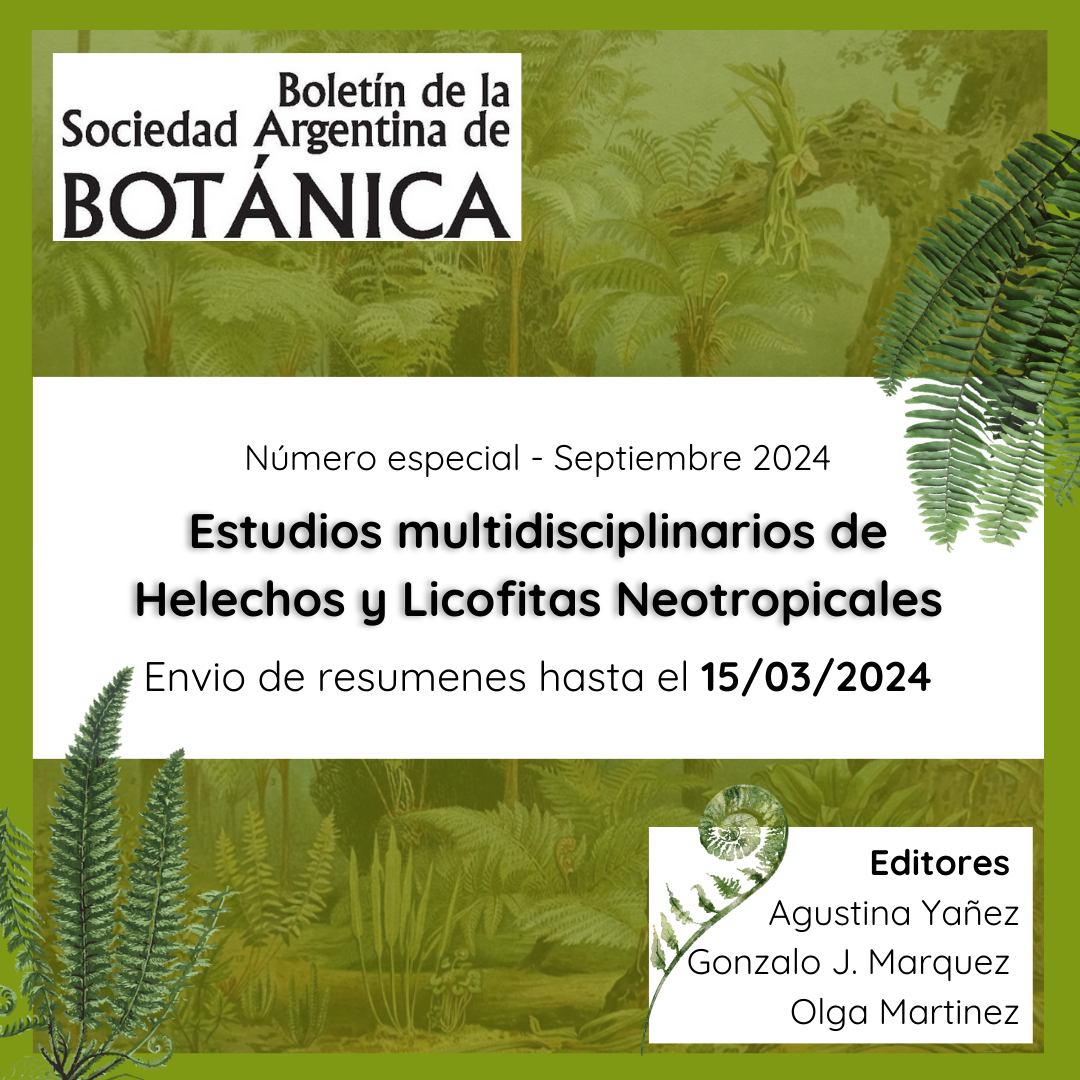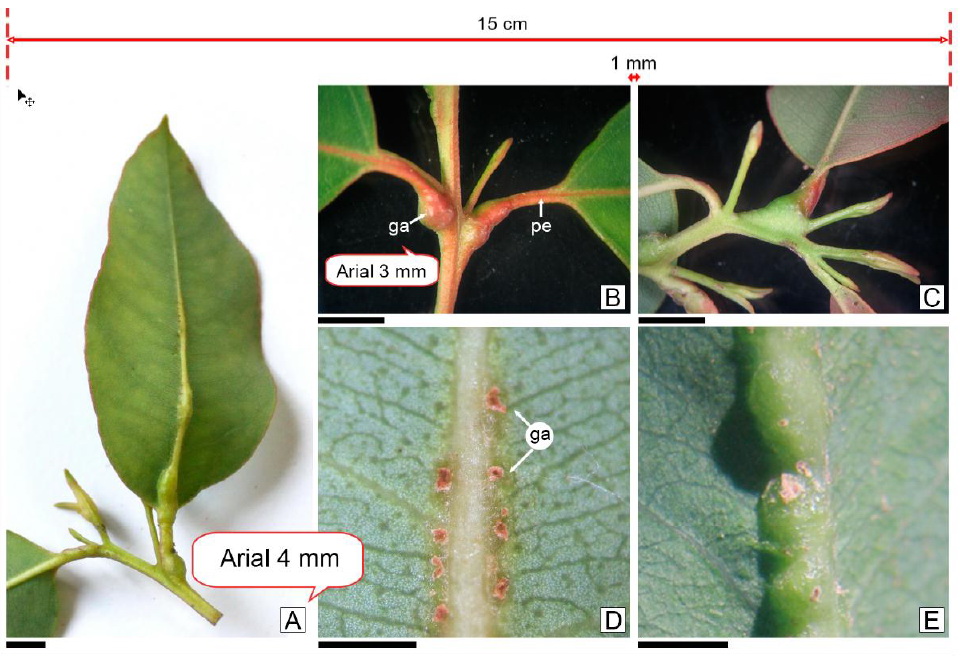Submissions
Submission Preparation Checklist
All submissions must meet the following requirements.
- The text complies with the bibliographic and style requirements indicated in the Guidelines for authors.
- I declare that the work is original and unpublished and was written by those who declare its authorship, it was prepared especially for publication in the Bulletin of the Argentine Botanical Society. The article must not have been published in the same or another language in any printed or electronic medium and must not be in another editorial process. COAUTHORY: All authors will be notified of the submission and included in the original submission, providing Name and Surname, email and orcid. One of the authors defines himself as an author of correspondence and undertakes to keep the co-authors informed throughout the editorial process.
- The manuscript is in OpenOffice© or Microsoft Word© format; the legends of the figures and tables are on a separate sheet in the manuscript. The figures are sent separately from the manuscript according to specific instructions (arranged in FIGURES: photos in JPG with 600 dpi and linear graphics in TIFF). The tables were made in Excel©.
- COMMENTS TO THE EDITOR: accompany the manuscript with a cover letter clearly expressing the original contribution of the work to your discipline or the development of new methodologies and their relationship with some of the branches of botany. You can provide at least 3 names of possible reviewers of the manuscript sent, indicating your e-mail address.
- Primary Research Data: the authors declare that they are aware of Law No. 26899/2013 and undertake to make their primary data available. The Argentine Republic adheres to the Open Access Policy https://www.argentina.gob.ar/normativa/nacional/ley-26899-223459. This Law and its regulations determine that researchers, professors, postdoctoral fellows and master's and doctoral students whose research activity is financed with public funds must deposit or expressly authorize the deposit of a copy of the final version of their published scientific-technological production or accepted for publication in the open access digital repositories of their institutions, within a period of no more than six (6) months from the date of its official publication or approval (Art.5º). Primary research data must be deposited within a period not exceeding five (5) years from the time of collection, in accordance with the policies established by the institutions. This is mandatory for data produced from 2013 onwards.
Original Articles
These are original scientific works from the whole spectrum of Botany and the various related organisms and fungi, both in basic and applied aspects.
Morphology & Anatomy
Editora de sección
ANA MARÍA GONZALEZ (Instituto de Botánica del Nordeste, Corrientes, Argentina)
Biología Reproductiva
Editora de sección
ANA CALVIÑO (Instituto Multidisciplinario de Biología Vegetal, IMBIV-CONICET, UNC, Córdoba, Argentina)
Briología
Editores de sección
GUILLERMO SUÁREZ (Fundación Miguel Lillo, S. M. de Tucumán, Argentina) JUAN LARRAIN (Pontificia Universidad Católica de Valparíso, Chile)
Plant conservation
Esta nueva sección está abierta a artículos y notas breves sobre la conservación de especies vegetales y de las comunidades que conforman. Publicará contribuciones originales en el área de la biología de la conservación de plantas (demografía, conservación genética, conservación in situ y ex situ, ecología y modelización de nicho, gestión, etc.).
Asimismo, como notas breves, podrá acoger evaluaciones de categorías de riesgo de especies vegetales y de ecosistemas, tanto globales como nacionales, siguiendo las metodologías propuestas por la Unión Internacional para la Conservación de la Naturaleza.
Editora de sección
KARINA L. SPEZIALE (Grupo de Investigaciones en Biología de la Conservación del INIBIOMA (CONICET-UNCO) Laboratorio Ecotono, San Carlos de Bariloche., Argentina)
Desarrollo
Editor de sección
GABRIEL BERNARDELLO (Instituto Multidisciplinario de Biología Vegetal, IMBIV-CONICET, UNC, Córdoba, Argentina)
Ecology and Conservation
Editoras de sección
LIA MONTTI (Instituto de Investigaciones Marinas y Costeras -IIMyC,CONICET, Universidad Nacional de Mar del Plata. Argentina)
KARINA L. SPEZIALE (Grupo de Investigaciones en Biología de la Conservación del INIBIOMA -CONICET-UNCO, Laboratorio Ecotono, San Carlos de Bariloche, Argentina)
Ethnobotany
Editores de sección
NORMA I. HILGERT (Instituto de Biología Subtropical, Puerto Iguazú, Argentina)
MANUEL PARDO DE SANTAYANA (Universidad Autónoma de Madrid, España)
Phychology
Editora de Sección
SYLVIA BONILLA (IECA, Facultad de Ciencias, Universidad de la República, Uruguay)
Physiology
Editor de sección
FEDERICO MOLLARD (Universidad de Buenos Aires, Argentina)
Phytochemistry
Editora de Sección
MARÍA PAULA ZUNINO (Universidad Nacional de Córdoba, IMBIV, Córdoba, Argentina)
Genetics & Evolution
Editora de sección
PAOLA GAIERO (Facultad de Ciencias, Universidad de la República, Montevideo, Uruguay)
Mycology
Editores de sección
LEOPOLDO IANONNE (Universidad de Buenos Aires, Argentina)
MARIA VICTORIA VIGNALE (Inst. Biotecnología de Misiones e Inst.Misionero de Biodiversidad, Misiones, Argentina)
Palynology
Editor de sección
GONZALO J. MARQUEZ (Universidad Nacional de La Plata, Argentina)
Paleobotany
Editora de sección
GEORGINA DEL FUEYO (Museo Argentino de Ciencias Naturales Bernardino Rivadavia, CABA, Argentina)
Vascular Plants
Editores de seccón
CAROLINA I. CALVIÑO (Universidad Nacional del Comahue, Bariloche, Argentina)
DIEGO GUTIÉRREZ (Museo Argentino de Ciencias Naturales Bernardino Rivadavia, CABA, Argentina)
FRANCO E. CHIARINI (Instituto Multidisciplinario de Biología Vegetal, Córdoba, Argentina).
ROBERTO M. SALAS (Instituto de Botánica del Nordeste, Corrientes, Argentina)
OLGA G. MARTINEZ (Universidad Nacional de Salta, Salta, Argentina)
Sp.Issue Ferns
NÚMERO ESPECIAL BOLETÍN DE LA SOCIEDAD ARGENTINA DE BOTÁNICA
“Nuevas tendencias en el estudio de Helechos y Licofitas Neotropicales: miradas multidisciplinarias para su conocimiento y conservación”

Los helechos y las licofitas se encuentran entre los grupos de plantas vasculares más carismáticos por su fascinante historia evolutiva, su rol en los ecosistemas pasados y presentes, sus estrategias de propagación y dispersión, sus características morfológicas y fisiológicas, así como sus usos tradicionales. Particularmente en el Neotrópico, constituyen un importante componente de la flora, albergando esta región varios hotspots de riqueza y endemismo de taxones. No obstante, la mayoría de las especies son particularmente vulnerables a la modificación y pérdida acelerada de hábitats naturales y los cambios en distintas variables climáticas, producto de la acción directa o indirecta del ser humano. Por este motivo, las investigaciones sobre helechos y licofitas en este área cobran especial relevancia, tanto en la carrera contra el tiempo por conocer y conservar, como por la necesidad de tener buena información para realizar un manejo sostenible del recurso.
En este contexto, el comité editorial del Boletín de la Sociedad Argentina de Botánica invita a la comunidad científica a participar del volumen dedicado a reunir y difundir los avances más recientes en el conocimiento científico de los helechos y licofitas de la región del Neotrópico y áreas vinculadas.
Se aceptarán artículos de investigación originales, revisiones, artículos de opinión y comunicaciones cortas. Los temas de interés para este volumen especial incluyen, aunque no se circunscriben a:
Taxonomía y sistemática
Ecología y conservación
Fisiología y bioquímica
Filogenia y evolución
Etnobotánica
Morfología y Anatomía
Palinología
Los artículos deben ser enviados a través del sistema de envío del BSAB. El plazo de recepción de artículos finaliza el 15 de marzo de 2024.
Más información en https://revistas.unc.edu.ar/index.php/BSAB/issue/view/2713
Agradecemos su interés en este número especial.
Editores Invitados:
Agustina Yañez. Investigadora Adjunta de CONICET. División Plantas Vasculares, Museo Argentino de Ciencias Naturales “Bernardino Rivadavia”. Especialista en morfología, distribución y sistemática de Helechos de la región paranaense. https://www.researchgate.net/profile/Agustina-Yanez-2
Gonzalo J. Marquez. Investigador Adjunto del CONICET. División Paleobotanica del Museo de La Plata (FCNYM, UNLP). Especialista en Palinología de Helechos. https://www.conicet.gov.ar/new_scp/detalle.php?id=23268&datos_academicos=yes
Olga Martinez. Facultad de Ciencias Naturales, Universidad Nacional de Salta - IBIGEO (Instituto De Bio y Geociencias Del NOA, CONICET-UNSa). Especialista en Helechos y Licofitas del NOA. https://orcid.org/0000-0003-1392-247X
Copyright Notice
Provides immediate and free OPEN ACCESS to its content under the principle of making research freely available to the public, which fosters a greater exchange of global knowledge, allowing authors to maintain their copyright without restrictions.
Material published in Bol. Soc. Argent. Bot. is distributed under a Creative Commons Attribution-NonCommercial-ShareAlike 4.0 International license.
Privacy Statement
Names and e-mail addresses entered in this journal shall be used exclusively for the purposes stated by this journal and shall not be made available for any other purpose or other person.





